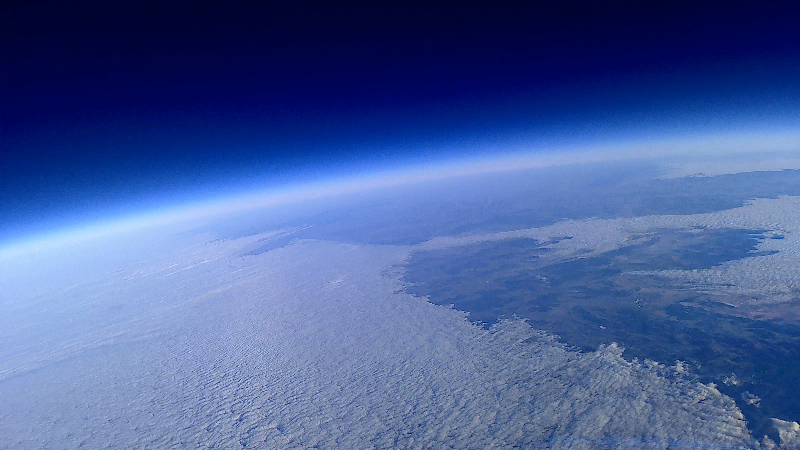Happy New Year 2017 to all of you! I'm starting the new year full of ideas and enthusiasm for new projects (some of which will become new QRP Labs products) and I hope you are too!
1. 5W HF Power Amplifier kit released at last!
2. New Ultimate3S QRSS/WSPR kit firmware v3.12
3. New enclosures and other new products
4. QSO Today podcast interview
5. QRP Labs diicussion group move
6. Balloon flights and ZL1RS ocean buoy news
7. Social media, Feedback, unsubscribing
1. 5W HF Power Amplifier kit released at last!
 It took longer than expected to get the 5W HF PA kits prepared, mostly due to lack of heatsinks, believe it or not1 The PCB was laid out to match a specific heatsink sample, and upon ordering a batch of them, we were informed that the heatsink is no longer manufactured! Allegedly the heatsink mold had been damaged. Several rounds of negotiation with the factory later, and they agreed to repair the mold and manufacture us a batch of the heatsinks. Then there was another week's delay due to a "lack of raw material"... err... aluminium shortage, in a heatsink factory? Anyway at long last as of 4th January 2017 the new 5W HF PA kit has finally been released in the QRP Labs shop!
It took longer than expected to get the 5W HF PA kits prepared, mostly due to lack of heatsinks, believe it or not1 The PCB was laid out to match a specific heatsink sample, and upon ordering a batch of them, we were informed that the heatsink is no longer manufactured! Allegedly the heatsink mold had been damaged. Several rounds of negotiation with the factory later, and they agreed to repair the mold and manufacture us a batch of the heatsinks. Then there was another week's delay due to a "lack of raw material"... err... aluminium shortage, in a heatsink factory? Anyway at long last as of 4th January 2017 the new 5W HF PA kit has finally been released in the QRP Labs shop!
The 5W HF PA kit is priced at $20, and the web page is http://qrp-labs.com/pa.
Features:
- Approx 16dB of gain at MF and HF (600m to 10m bands inclusive)
- IRF510 MOSFET PA stage providing 5W or more RF output from 200mW drive (varies by band)
- Raised-cosine keying envelope generation
- Option for standalone envelope shaping, without external microprocessor control
- 80 x 37mm PCB, compatible with Ultimate3S transmitter kit
- Discrete component power modulator with foldback current limiting
- Designed for typically 12V or 13.8V operation
- Large aluminium heatsink
- SMA or pin header inputs and outputs (SMA connectors are optional extras)
- You can substitute the RD15HVF1 transistor for VHF or UHF operation
An IRF510 MOSFET PA is not really complicated but the difference here, is that this PA is designed to allow microcontroller control of the RF envelope, so that an accurate raised cosine keying profile can be closely replicated. A raised cosine envelope shape allows keying without generating key-clicks what interfere with communications on nearby frequencies. In the kit a microcontroller loads 8-bit values into a shift register, whose outputs drive a Digital to Analogue Converter (DAC). The DAC output controls a discrete component power modulator with foldback current limiting, which proportionately varies the RF output envelope peak-to-peak amplitude.
The kit can be connected directly to the Ultimate3S kit, and firmware version v3.12 includes code to generate the necessary sequence of raised cosine coefficients and load them into the shift register. Application note AN004 gives details of connecting the 5W HF PA kit to the Ultimate3S kit, see http://qrp-labs.com/appnotes. The rise/fall times of the envelope are configurable by a menu entry in the Ultimate3S.
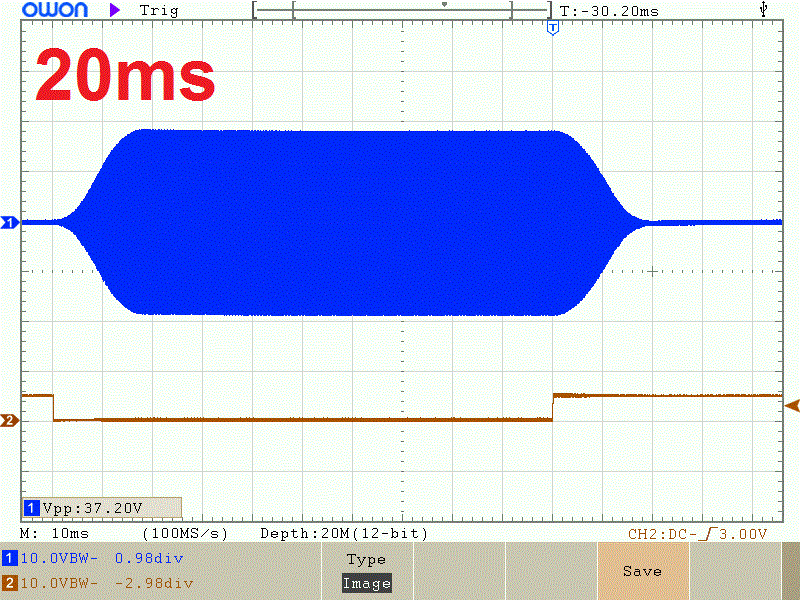 The kit can also be used as a standalone 5W HF PA in your homebrew projects! The circuit has a neat design feature where the 8-bit 74HC595 shift register can be replaced with an ATtiny84 processor which is programmed to generate a raised cosine keying envelope. A 5W CW transmitter with beautiful raised cosine envelope keying can be implemented with just a morse key to ground, and a signal source such as the rotary encoder tuned VFO kit http://qrp-labs.com/vfo. The rise/fall time can be adjusted using an analog voltage into the RC1 chip, which could be set by a potential divider trimmer resistor, for example. The "RC1" key shape processor is available as an option when purchasing the PA kit (+$4). This option is described in App Note AN005 see http://qrp-labs.com/appnotes. The "RC1" chip must not be used when driving the 5W HF PA kit with an Ultimate3S transmitter.
The kit can also be used as a standalone 5W HF PA in your homebrew projects! The circuit has a neat design feature where the 8-bit 74HC595 shift register can be replaced with an ATtiny84 processor which is programmed to generate a raised cosine keying envelope. A 5W CW transmitter with beautiful raised cosine envelope keying can be implemented with just a morse key to ground, and a signal source such as the rotary encoder tuned VFO kit http://qrp-labs.com/vfo. The rise/fall time can be adjusted using an analog voltage into the RC1 chip, which could be set by a potential divider trimmer resistor, for example. The "RC1" key shape processor is available as an option when purchasing the PA kit (+$4). This option is described in App Note AN005 see http://qrp-labs.com/appnotes. The "RC1" chip must not be used when driving the 5W HF PA kit with an Ultimate3S transmitter.
The 'scope trace shown here (right) is a 12wpm "dit" (duration 100ms) with a 20ms rise/fall time to illustrate the raised cosine shape. In practice rise/fall time of 5 to 10ms is commonly used.
Finally if you don't want raised cosine envelope keying at all and all you want is a dead simple PA, there is also an option to omit and bypass all the fancy stuff. There is an assembly manual for the simplified assembly process.
The kit is capable of lots of modification too. The first that comes to mind is replacing the IRF510 with an RD15HVF1 transistor, if you want to operate VHF 6m and up. The IRF510 does a good job from 600m to 10m, but I can only call its performance "pathetic" at 6m. The RD15HVF1 is popular in PAs and is designed for operation up to VHF and UHF. It has a different pinout to the IRF510 but separate pads have been added on the PCB to suit the RD15HVF1, if you wish to substitute it. Other possible modifications would include higher power output by using a higher supply voltage (and modifying the current limiting to permit this).
The full assembly document is comprehensive, and also includes detailed discussion of the various circuit blocks. All in all, there's a LOT of fun in this kit, for $20!
2. New Ultimate3S QRSS/WSPR transmitter firmware v3.12
The release of the 5W HF PA Kit also necessitated a new firmware version for people who wish to use it with the Ultimate3S transmitter, to load the raised cosine coefficients into the 5W HF PA kit shift register.
- A new configuration parameter "Shaping {ms Max}" configures the raised cosine generation when using the PA kit. The rise/fall time of the raised cosine keying envelope is variable from 2 to 99ms. See App Note AN004 for further details.
- The 32,768 bytes of available program space were all consumed 100.0% in firmware v3.11. So it was time after 2 years, to finally tackle the tricky issue of eliminating floating point calculations from the code, to reduce the code size. It was NOT easy, I can tell you. But as a result, the Si5351A configuration and tone step algorithms ARE now integer only, freeing up enough code space to add the new features in this release.
- The backlight now has an optional timeout parameter. The Backlight parameter has been changed to {Bright Timeout}, where the timeout is specified in seconds, 1..999 seconds (0 means no timeout).
- When in extended WSPR mode, send the two WSPR pieces sequentially, not one each alternate cycle.
- Write EEPROM version ID last when doing a factoryReset, so that if it is interrupted it will happen again next power up.
- Removed flicker during GPS calibration when backlight control is used, and is at full brightness.
- Reference frequency configuration defaults to 27,004,000, which is a lot closer to what is usual for the crystal, than the former default value 27,000,000.
As usual the new firmware version chip is available in the QRP Labs shop here, or if you have AVR programming equipment you can download the .hex file and upgrade your existing chip, from the QRP Labs group (see section 5 below, for details).
 3. New enclosures and other new products
3. New enclosures and other new products
The VFO/SigGen kit and the Clock kit are based on the same PCB and components as the Ultimate3S transmitter kit. They also fit into the QRP Labs Ultimate3/3S aluminium case and accessories kit. However, it was perhaps a bit misleading that the front panel was labelled "Ultimate3S QRSS/WSPR". So we have got some different front and rear panels manufactured, that make it possible to offer additional enclosures:
- Ultimate3/3S transmitter kit enclosure, the classic kit that has been available for a long time now
- VFO/SigGen kit enclosure - a different front panel only
- Clock enclosure - different front and rear panels
- Custom enclosure - where you choose which front and rear panels you want
The new enclosure kits cost the same ($22 + shipping) and include the same top/bottom pieces as the existing Ultimate3/3S box, containing 2 buttons, 2 toggle switches, D9 connector (for GPS, etc), power socket, power plug, BNC connector, 4 self-adhesive cabinet feet, and all screws/spacers required to mount the LCD and PCB assembly to the front panel.
We also manufactured a front panel with the holes and LCD cut-out, and no silkscreen printing at all except for "QRP Labs"; and a blank un-drilled, un-cut, un-printed panel. The panels are available for purchase separately too.
Finally, we have sourced a 20mm knob suitable for fitting to the rotary encoder supplied in the VFO/SigGen kit. This rotary encoder can be installed in the lower right hole of the front panel, and although it's a tight fit, the 20mm knob does fit and can be comfortably operated. The knob costs $0.70 and the shop page is here.
4. QSO Today podcast interview
QRP Labs chief of R&D was honoured to be interviewed by Eric 4Z1UB's weekly QSO Today Podcast, episode #125 aired on Christmas Day, 25-Dec-2016. You can listen to the interview here http://www.qsotoday.com/podcasts/G0UPL by clicking the "Listen to Podcast" button. I have been listening to some of the earlier interviews while melting solder in the lab - there's some really fascinating discussion in there, and it really brings home again the point about how wide and diverse the amateur radio hobby is.
5. QRP Labs discussion group move
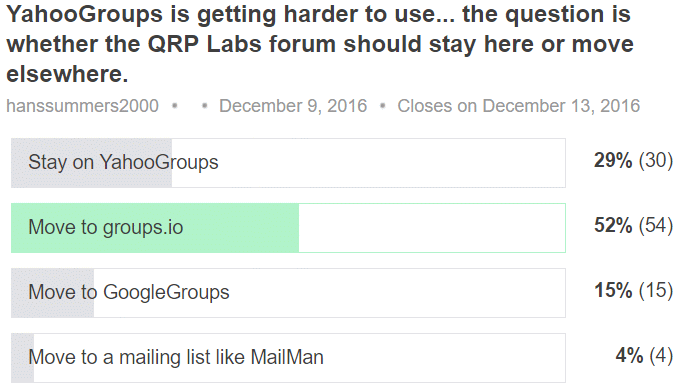 QRP Labs has had a lively discussion group since the first kit was produced in May 2010 to accompany a presentation at Dayton FDIM that year. But since then, Yahoo has hit the news headlines multiple times over hacking of personal data. Group members have from time to time complained about message delays, message duplication, messages lost - and none of this appears to have improved over time. Furthermore Yahoo attempt to demand an increasing amount of private information about the account holder - which can be circumvented with some considerable effort.
QRP Labs has had a lively discussion group since the first kit was produced in May 2010 to accompany a presentation at Dayton FDIM that year. But since then, Yahoo has hit the news headlines multiple times over hacking of personal data. Group members have from time to time complained about message delays, message duplication, messages lost - and none of this appears to have improved over time. Furthermore Yahoo attempt to demand an increasing amount of private information about the account holder - which can be circumvented with some considerable effort.
Therefore on concerns of security, privacy and reliability, the group held a referendum about what to do. I'm going to resist the temptation to recycle all my bad jokes about polls, referendums, Yexit, the popular vote, etc etc. Suffice it to say that moving to groups.io won the poll by a convincing majority and accordingly within a few days we moved everything to groups.io. The groups.io admin provide great assistance with such migrations, and the entire membership of the group (around 1,500 members) was moved to groups.io, along with the entire message archive since May 2010, and all the folders, photos, files etc.
groups.io is run by the same people who originally set up the groups website which was later purchased by Yahoo and became YahooGroups. The website is fast and crisp, messages appear to be delivered near-instantly, and all of the content all migrated across successfully.
If you a QRP Labs kit owner or interested in the kits, and are not already a member of the group, come and join! The QRP Labs group page is https://groups.io/g/QRPLabs.
6. Balloon flights and ZL1RS ocean buoy news
There was one QRP Labs balloon flight in December, by Daniel DL6OW, named STELLA4. For this flight Dan took a departure from his previous mylar film "floater" balloons with ultra-light payloads, and opted instead for the more common short duration latex balloons. These are larger, carry a bigger payload, and are filled with more helium. They ascend for a few hours to a very high altitude, then burst and come back down (with a parachute). Dan says he wanted to finish his tank of helium and then recommence future flights with "floater" balloons using hydrogen gas instead, like Dave VE3KCL's flights.
STELLA4 carried an Ultimate3S WSPR transmitter, UHD video camera, and GSM/GPRS tracker. There was a crash soon after launch due to a gas miscalculation, but STELLA4 was re-launched the second time successfully. Unfortunately the crash appears to have broken a wire between the microcontroller and the Si5351A Synth, with the result that only an un-modulated carrier was transmitted, no WSPR. But upon landing the GSM/GPRS tracker was functioning fine, and so the payload was swiftly recovered. Dan got some fantastic photos from the "edge of space" and has a flight video on youtube. You can see all the photographs and the video, at the STELLA4 webpage on QRP Labs, please visit http://qrp-labs.com/flights/stella4
Meanwhile Bob ZL1RS' "ocean floater" project is still travelling the South Pacific after 234 days at sea! It uses the QRP Labs Ultimate3S transmitter sending WSPR and JT transmissions. The position is now RH50XT, somewhere roughly half-way between Fiji and New Caledonia. It's fascinating also to look at Bob's chart of reported battery voltage plotted on the manufacture's voltage/life curve. There's still PLENTY of energy left in those batteries!
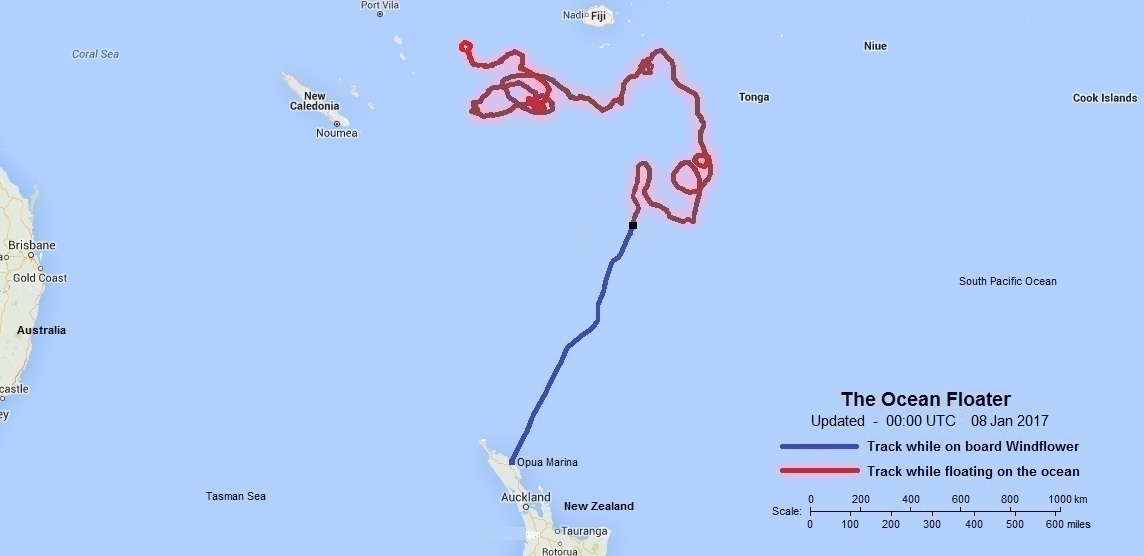
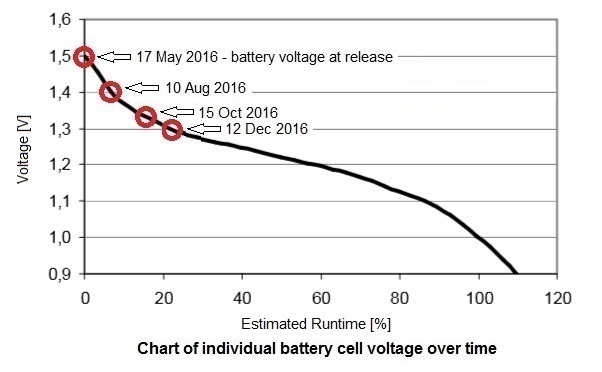
7. Social media, feedback, unsubscribing
Social media: QRP Labs has the following presence on social media. If you use these social media then please join or follow QRP Labs! Announcements such as new products, balloon launches, etc., will be made first in these media!
1) QRP Labs groups.io discussion group https://groups.io/g/QRPLabs for discussion and support on all QRP Labs products
2) QRP Labs Facebook page https://www.facebook.com/QRPlabs/
3) QRP Labs is @qrplabs on Twitter https://twitter.com/qrplabs
Feedback: As always, please do write with any comments, ideas, criticism, feedback of any kind!
Unsubscribing: If you want to unsubscribe from this monthly newsletter, then either log in to your QRP Labs shop account and un-check your newsletter preference, OR, email and we'll take care of it.

